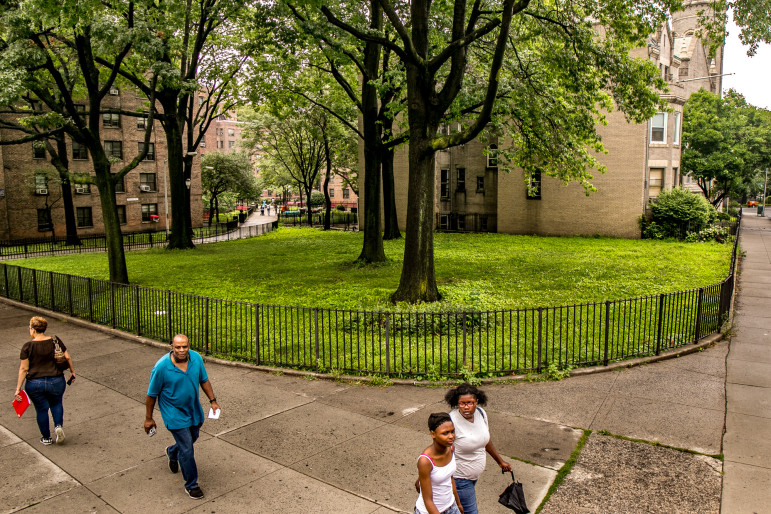
Adi Talwar
Green space at Ingersoll Houses, one of three NYCHA developments affected by a proposal for affordable housing that concerns some tenant leaders.
NYCHA’s plan to build affordable housing at existing public housing developments has generated skepticism and opposition from some residents. But an alliance of advocates, tenant leaders and elected officials offered qualified support for the proposal in a letter to the authority this week.
The Alliance to Preserve Public Housing acknowledged steps the de Blasio administration has taken to shore up public housing, the continuing fiscal threat facing the agency and its huge and growing capital backlog.
The Alliance also noted the potential for NYCHA’s infill plan—which is supposed to create 17,000 units of new housing, 80 percent of it “affordable”, on 50 to 60 of NYCHA’s 328 developments—to create needed new housing and generate revenue for the cash-strapped authority.
But the Alliance said its support for the infill initiative was contingent on an improved resident engagement process, a requirement that the new housing be built by companies paying prevailing wages and with significant hiring of NYCHA residents to take part in the work, and the use of a public-private ownership structure for the new housing “in which NYCHA maintains as much control as possible over the foreseeable future.”
Read the letter here:
NYC Alliance to Preserve Public Housing Comments on FY2016 NYCHA Annual Plan
While most of the infill projects will be 100 percent affordable, some will mix affordable- and market rents. And even the affordable units might not be priced to serve very low-income New Yorkers. So the Alliance recommends, “The mixed-income model should be abandoned, except where the resident community and NYCHA reach agreement on the degree of affordability.” It adds that developments should strive to target low-income tenants and that “admission preferences for all affordable housing developed on NYCHA land should specify 25 percent of units for current residents and 25 percent for the formerly homeless.”
The Alliance’s letter address other NYCHA policies as well—notably recommending improvements to the resident association system, whose shortcomings City Limits investigated earlier this year.
The de Blasio administration infill push is a major part of the citywide affordability plan and part of its NextGeneration strategy to save NYCHA. So the qualified support of the Alliance—which encompasses nine major civic organizations, nine public-housing resident associations, two community boards, two City Councilmembers two Assemblymembers and four state senators—is significant. The question is whether NYCHA will shape its plan to address the coalition’s concerns.









One thought on “Key Coalition Backs NYCHA Infill Plan, with Conditions”
city limits you have no guts to understand the real problem….its
impossible to fire incompetent workers…..why would any contractor hire
people from NYCHA? to have this much of a backlog means at least 20%
or more should be fired……look at all the great people who would beg
for their jobs..